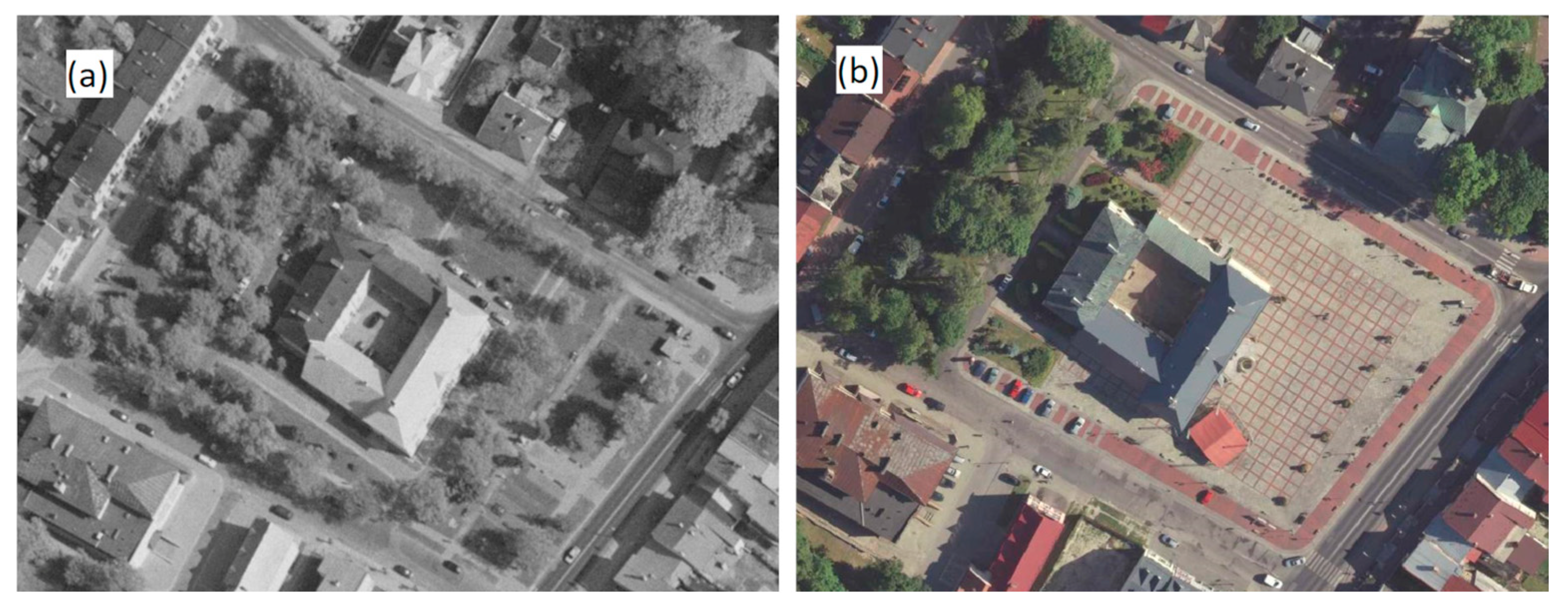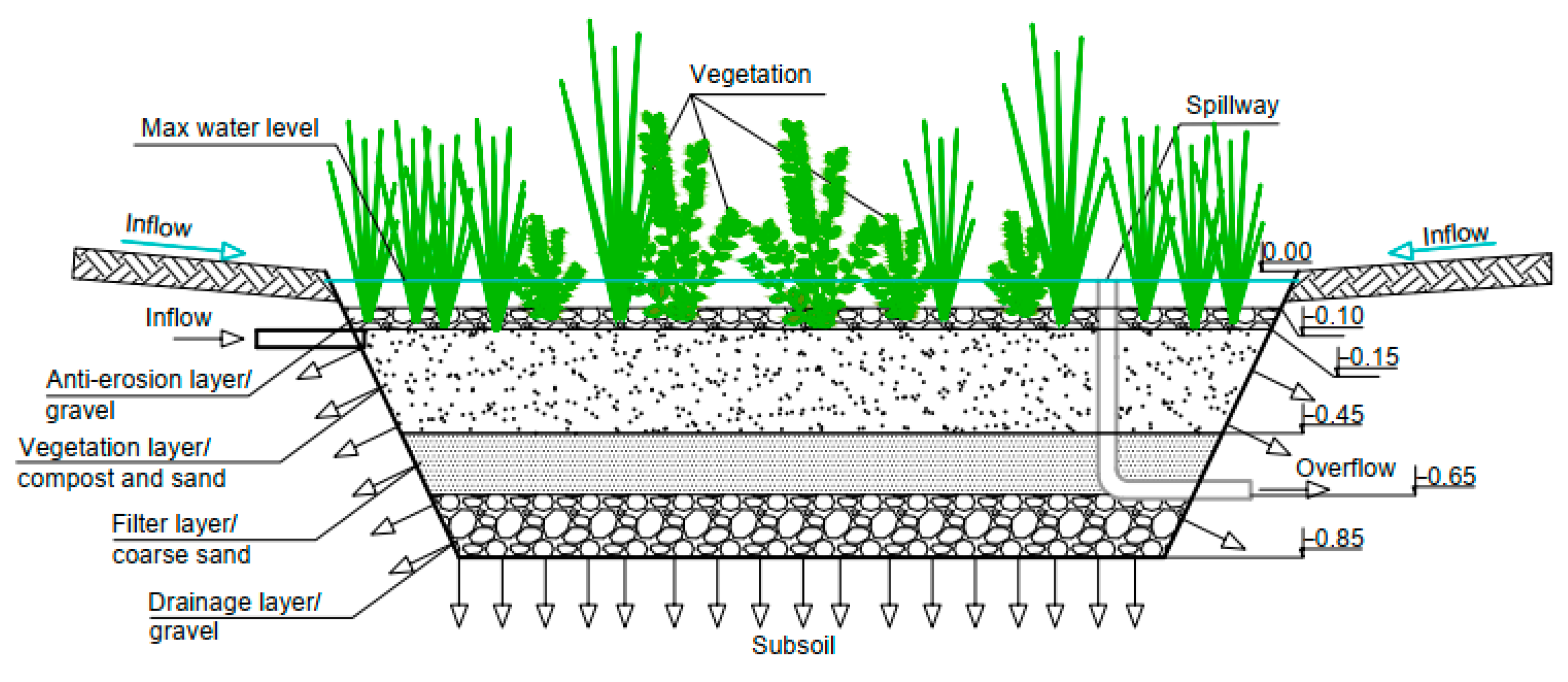Hydrologic Efficiency of Rain Gardens as Countermeasures to Overuse of Concrete in Historical Public Spaces
Abstract
1. Introduction
2. Materials and Methods
2.1. Object Description
2.2. Numerical Modeling
2.3. Rain Gardens
2.4. Simulation Results
3. Results
3.1. Runoff Generation
3.2. Model Sensitivity Analysis
4. Discussion
5. Conclusions
- Revitalization of the tested historical squares in three cities in Poland, related to the significant increase in the paved area, clearly affected runoff generation for the modeled real weather conditions, resulting in an increase in runoff volume and peak flows;
- The calculated increase in runoff volume after revitalization was in the range 78.2–90.9%, while the determined increase in runoff peak flows reached a level of 108–141.7%, which in turn may pose a significant threat to the existing rainwater drainage systems;
- The observed increases in the simulated runoff characteristics and general components of the water balance were dependent on the range of revitalization and green area removal;
- The designed rain gardens, as a green architecture measure, according to the results of the numerical modeling, allowed partial restoration of the disturbed water balance of the studied historical urban watersheds due to the reduction in runoff volume of 18.1–30.2% and the decrease in runoff peak flows of 17.9–32.0%;
- The calculations of the water balance for the studied catchments after the rain garden installation showed also increases in infiltration and evaporation during the numerical simulation duration;
- The performed statistical analysis of the obtained results showed that the observed differences in the runoff volumetric flow for all the tested variants of the rainwater management differed significantly;
- The presented results were based on uncalibrated SWMM models; thus, the results should be treated as preliminary;
- The presented results should be continued at different locations, for longer real weather periods and with the assumption of the variable application of several LID types.
Supplementary Materials
Author Contributions
Funding
Institutional Review Board Statement
Informed Consent Statement
Data Availability Statement
Conflicts of Interest
Abbreviations
| LID | Low-Impact Development |
| USA EPA | Environmental Protection Agency |
| SWMM | Storm Water Management Model |
| WMO | World Meteorological Organization |
| LAI | Leaf Area Index |
References
- Mencwel, J. Betonoza. Jak Niszczy Się Polskie Miasta; Krytyka Polityczna: Warszawa, Poland, 2020. (In Polish) [Google Scholar]
- Concrete in Cities—Why Did We Get Rid of Greenery in Cities? Available online: https://www.money.pl/gospodarka/betonoza-w-miastach-dlaczego-pozbylismy-sie-zieleni-z-miast-6808029991025152a (accessed on 24 January 2025). (In Polish).
- Betonoza is Harmful to Health. Available online: https://zdrowie.pap.pl/srodowisko/betonoza-szkodzi-zdrowiu (accessed on 24 January 2025). (In Polish).
- Urban Planner: “Concreting” Public Spaces Is a Passing Trend. Available online: https://samorzad.pap.pl/kategoria/aktualnosci/urbanistka-betonoza-przestrzeni-publicznej-mijajacy-trend (accessed on 24 January 2025). (In Polish).
- Betonoza—How Does the “Revitalization” of Polish Urban Space Harm Everyone Around? Available online: https://www.gazetakongresy.pl/betonoza-jak-rewitalizacja-polskiej-przestrzeni-miejskiej-szkodzi-wszystkim-wokol/ (accessed on 24 January 2025). (In Polish).
- Geoportal. Available online: https://www.geoportal.gov.pl/ (accessed on 24 January 2025). (In Polish)
- Geo-System. Available online: https://polska.e-mapa.net/ (accessed on 24 January 2025). (In Polish).
- Dymek, D.; Jóźwik, J. Kształtowanie placów miejskich na przykładzie miast województwa lubelskiego. Ann. UMCS Sec. B 2021, 76, 28. [Google Scholar] [CrossRef]
- Widomski, M.K.; Musz-Pomorska, A. Numerical assessment of ra-inwater management in historical central town square catchment with different surface sealing. Gaz Woda i Technika Sanitarna 2024, 9, 17–25. [Google Scholar] [CrossRef]
- Janucha-Szostak, A. Blue-green infrastructure as a tool for urban adaptation to climate change and rainwater management. Zesz. Nauk. Politech. Poznańskiej. Archit. Urban. Archit. Wnętrz 2020, 3, 37–74. (In Polish) [Google Scholar] [CrossRef]
- Janucha-Szostak, A.; Ogorzelska, A.; Peplińska, S. Modernization of the market squares of small and medium-sized towns facing the challenges of adaptation to climate change. Zesz. Nauk. Politech. Poznańskiej. Archit. Urban. Archit. Wnętrz 2023, 15, 243–260. (In Polish) [Google Scholar] [CrossRef]
- Bąk, J.; Barjenbruch, M. Benefits, Inconveniences, and Facilities of the Application of Rain Gardens in Urban Spaces from the Perspective of Climate Change—A Review. Water 2022, 14, 1153. [Google Scholar] [CrossRef]
- Boguniewicz-Zabłocka, J.; Capodaglio, A.G. Analysis of Alternatives for Sustainable Stormwater Management in Small Developments of Polish Urban Catchments. Sustainability 2020, 12, 10189. [Google Scholar] [CrossRef]
- Li, C.; Sun, N.; Lu, Y.; Guo, B.; Wang, Y.; Sun, X.; Yao, Y. Review on Urban Flood Risk Assessment. Sustainability 2023, 15, 765. [Google Scholar] [CrossRef]
- Serre, D.; Barroca, B.; Diab, Y. Urban Flood Mitigation: Sustainable Options. WIT Trans. Ecol. Environ. 2010, 129, 299–309. [Google Scholar] [CrossRef]
- Li, Z.; Wang, Z.; Wu, L.; Huang, W.; Peng, W. Evaluating the effect of building patterns on urban flooding based on a boosted regression tree: A case study of Beijing, China. Hydrol. Process. 2023, 37, e14932. [Google Scholar] [CrossRef]
- Kasprzyk, M.; Szpakowski, W.; Poznańska, E.; Boogaard, F.C.; Bobkowska, K.; Gajewska, M. Technical solutions and benefits of introducing rain gardens—Gdańsk case study. Sci. Total Environ. 2022, 835, 155487. [Google Scholar] [CrossRef]
- Toda, K. Urban Flooding and Measures. J. Disaster Res. 2007, 2, 143–152. [Google Scholar] [CrossRef]
- Singh, H.; Nielsen, M.; Greatrex, H. Causes, impacts, and mitigation strategies of urban pluvial floods in India: A systematic review. Int. J. Disaster Risk Reduct. 2023, 93, 103751. [Google Scholar] [CrossRef]
- Szeląg, B.; Suligowski, R.; De Paola, F.; Siwicki, P.; Majerek, D.; Łagód, G. Influence of urban catchment characteristics and rainfall origins on the phenomenon of stormwater flooding: Case study. Environ. Model. Soft. 2022, 150, 105335. [Google Scholar] [CrossRef]
- Fatone, F.; Szeląg, B.; Kiczko, A.; Majerek, D.; Majewska, M.; Drewnowski, J.; Łagód, G. Advanced sensitivity analysis of the impact of the temporal distribution and intensity of rainfall on hydrograph parameters in urban catchments. Hydrol. Earth Syst. Sci. 2021, 25, 5493–5516. [Google Scholar] [CrossRef]
- Pour, S.H.; Wahab, A.K.A.; Shahid, S.; Asaduzzaman, M.; Dewan, A. Low impact development techniques to mitigate the impacts of climate-change-induced urban floods: Current trends, issues and challenges. Sustain. Cities Soc. 2020, 62, 102373. [Google Scholar] [CrossRef]
- Venegas-Cordero, N.; Mediero, L.; Piniewski, M. Urbanization vs. climate drivers: Investigating changes in fluvial floods in Poland. Stoch. Environ. Res. Risk Assess. 2024, 38, 2841–2857. [Google Scholar] [CrossRef]
- Dawson, R.J.; Speight, L.; Hall, J.W.; Djordjevic, S.; Savic, D.; Leandro, J. Attribution of flood risk in urban areas. J. Hydroinform. 2008, 10, 275–288. [Google Scholar] [CrossRef]
- Torgersen, G.; Navrud, S. Singing in the rain: Valuing the economic benefits of avoiding insecurity from urban flooding. J. Flood Risk Manag. 2018, 11, e12338. [Google Scholar] [CrossRef]
- Prashar, N.; Lakra, H.S.; Rajib Shaw, R.; Kaur, H. Urban Flood Resilience: A comprehensive review of assessment methods, tools, and techniques to manage disaster. Prog. Disaster Sci. 2023, 20, 100299. [Google Scholar] [CrossRef]
- Atlas of the Effects of Extreme Phenomena in Poland, IOŚ-PIB. 2022. Available online: https://ios.edu.pl/raporty-i-analizy/zmiany-klimatu/atlas-skutkow-zjawisk-ekstremalnych/ (accessed on 24 January 2025). (In Polish).
- Concrete Cost Them Dearly. They Want to Change That, But Planting Trees Alone is Not Enough. Available online: https://spidersweb.pl/2024/08/betonoza-polskie-miasta-zielen.html (accessed on 24 January 2025). (In Polish).
- A Year Ago, We Started Our Campaign Odbetonowani. Available online: https://miastojestnasze.org/rok-temu-ruszyla-nasza-akcja-odbetonowani/ (accessed on 24 January 2025). (In Polish).
- Concrete is Out of Fashion. It’s Time for a Green Revolution. Available online: https://klimat.rp.pl/walka-o-klimat/art39493931-betonoza-jest-juz-niemodna-czas-na-zielona-rewolucje (accessed on 24 January 2025). (In Polish).
- The Fight Against “Betonoza” in Wrocław Continues. Available online: https://gazetawroclawska.pl/walka-z-betonoza-we-wroclawiu-trwa-place-bez-zieleni-zamienia-sie-w-parki-zobacz-ktore/ar/c1-18785221 (accessed on 24 January 2025). (In Polish).
- De-Concreting and Greening of Public Spaces in the City. Available online: https://www.gov.pl/web/nfosigw/odbetonowanie-i-zazielenienie-przestrzeni-publicznych-w-miescie (accessed on 24 January 2025). (In Polish)
- Protection and Restoration of Biological and Landscape Diversity. Available online: https://www.gov.pl/web/nfosigw/ochrona-i-przywracanie-roznorodnosci-biologicznej-i-krajobrazowej (accessed on 24 January 2025). (In Polish)
- Mehryar, S.; Surminski, S. Investigating flood resilience perceptions and supporting collective decision-making through fuzzy cognitive mapping. Sci. Total Environ. 2022, 837, 155854. [Google Scholar] [CrossRef]
- Zhu, S.; Li, D.; Feng, H.; Na Zhang, N. The influencing factors and mechanisms for urban flood resilience in China: From the perspective of social-economic-natural complex ecosystem. Ecol. Indic. 2023, 147, 109959. [Google Scholar] [CrossRef]
- Davis, A.P. Green engineering principles promote low-impact development. Environ. Sci. Technol. 2005, 39, 338A–344A. [Google Scholar] [CrossRef]
- Liu, H.; Wang, Y.; Zhang, C.; Chen, A.S.; Fu, G. Assessing real options in urban surface water flood risk management under climate change. Nat. Hazards 2018, 94, 1–18. [Google Scholar] [CrossRef]
- Nguyen, H.Q.; Radhakrishnan, M.; Bui, T.K.N.; Tran, D.D.; Ho, L.P.; Tong, V.T.; Huynh, L.T.; Chau, N.X.; Ngo, T.T.; Pathirana, A.; et al. Evaluation of retrofitting responses to urban flood risk in Ho Chi Minh City using the Motivation and Ability (MOTA) framework. Sustain. Cities Soc. 2019, 47, 101465. [Google Scholar] [CrossRef]
- Hettiarachchi, S.; Wasko, C.; Ashish Sharma, A. Rethinking urban storm water management through resilience—The case for using green infrastructure in our warming world. Cities 2022, 128, 103789. [Google Scholar] [CrossRef]
- Shafique, M.; Kim, R. Retrofitting the Low Impact Development practices into developed urban areas including barriers and potential solution. Open Geosci. 2017, 9, 240–254. [Google Scholar] [CrossRef]
- Zhang, L.; Ye, Z.; Shibata, S. Assessment of Rain Garden Effects for the Management of Urban Storm Runoff in Japan. Sustainability 2020, 12, 9982. [Google Scholar] [CrossRef]
- Du, S.; Wang, C.; Shen, J.; Wen, J.; Gao, J.; Wu, J.; Lin, W.; Xu, H. Mapping the capacity of concave green land in mitigating urban pluvial floods and its beneficiaries. Sustain. Cities Soc. 2019, 44, 774–782. [Google Scholar] [CrossRef]
- Kukadia, J.; Lundholm, M.; Russell, I. Designing Rain Gardens: A Practical Guide; Urban Design: London, UK, 2018; Available online: https://www.urbandesignlearning.com/resources/publications/details?recordId=recOcYos3UmeZ9PMw (accessed on 24 July 2024).
- Design Criteria for Bioretention—Minnesota Stormwater Manual. Available online: https://stormwater.pca.state.mn.us/index.php/Design_criteria_for_bioretention (accessed on 17 February 2025).
- Burszta-Adamiak, W.; Biniak-Pieróg, M.; Dąbek, P.B.; Sternik, A. Rain garden hydrological performance—Responses to real rainfall events. Sci. Total Environ. 2023, 887, 164153. [Google Scholar] [CrossRef]
- Sagrelius, P.Ö.; Blecken, G.; Hedström, A.; Ashley, R.; Viklander, M. Sustainability performance of bioretention systems with various designs. J. Environ. Manag. 2023, 34, 117949. [Google Scholar] [CrossRef]
- Ayutthaya, T.K.N.; Suropan, P.; Sundaranaga, C.; Phichetkunbodee, N.; Anambutr, R.; Suppakittpaisarn, P.; Rinchumphu, D. The influence of bioretention assets on outdoor thermal comfort in the urban area. Energy Rep. 2023, 9, 287–294. [Google Scholar] [CrossRef]
- Demuzere, M.; Orru, K.; Heidrich, O.; Olazabal, E.; Geneletti, D.; Orru, H.; Bhave, A.G.; Mittal, N.; Feliú, E.; Faehnle, M. Mitigating and adapting to climate change: Multi-functional and multi-scale assessment of green urban infrastructure. J. Environ. Manag. 2014, 146, 107–115. [Google Scholar] [CrossRef] [PubMed]
- Luo, H.; Guan, L.; Jing, Z.; He, B.; Cao, X.; Zhang, Z.; Tao, M. Performance Evaluation of Enhanced Bioretention Systems in Removing Dissolved Nutrients in Stormwater Runoff. Appl. Sci. 2020, 10, 3148. [Google Scholar] [CrossRef]
- Zhang, W.; Tao, K.; Sun, H.; Che, W. Influence of urban runoff pollutant first flush strength on bioretention pollutant removal performance. Water Sci. Technol. 2022, 86, 1478–1495. [Google Scholar] [CrossRef] [PubMed]
- Dobbie, M.F.; Farrelly, M.A. Using best-worst scaling to reveal preferences for retrofitting raingardens in suburban streets. Urban For. Urban Green. 2022, 74, 127619. [Google Scholar] [CrossRef]
- Siwiec, E.; Erlandsen, A.; Vennemo, H. City greening by rain gardens-costs and benefits. Environ. Prot. Nat. Resour. 2018, 29, 1–5. [Google Scholar] [CrossRef]
- Aerts, J.C.J.H. A Review of Cost Estimates for Flood Adaptation. Water 2018, 10, 1646. [Google Scholar] [CrossRef]
- Li, J.; Tao, T.; Kreidler, M.; Burian, S.; Yan, H. Construction Cost-Based Effectiveness Analysis of Green and Grey Infrastructure in Controlling Flood Inundation: A Case Study. J. Water Manag. Model. 2019, 27, C466. [Google Scholar] [CrossRef]
- Ramos, H.M.; Besharat, M. Urban Flood Risk and Economic Viability Analyses of a Smart Sustainable Drainage System. Sustainability 2021, 13, 13889. [Google Scholar] [CrossRef]
- Wilbers, G.J.; de Bruin, K.; Seifert-Dähnn, I.; Lekkerkerk, W.; Li, H.; Budding-Polo, B.M. Investing in Urban Blue–Green Infrastructure—Assessing the Costs and Benefits of Stormwater Management in a Peri-Urban Catchment in Oslo, Norway. Sustainability 2022, 14, 1934. [Google Scholar] [CrossRef]
- Funke, F.; Kleidorfer, M. Sensitivity of sustainable urban drainage systems to precipitation events and malfunctions. Blue-Green Syst. 2024, 6, 33–52. [Google Scholar] [CrossRef]
- Szpak, A.; Modrzyńska, J.; Piechowiak, J. Resilience of Polish cities and their rainwater management policies. Urban Clim. 2022, 44, 101228. [Google Scholar] [CrossRef]
- New Rain Gardens in the City. Available online: https://lublin.eu/mieszkancy/srodowisko/aktualnosci/nowe-ogrody-deszczowe-w-miescie,650,1945,1.html (accessed on 24 February 2025). (In Polish).
- Statistics Poland. Available online: https://bdl.stat.gov.pl/bdl/dane/podgrup/tablica (accessed on 24 January 2025). (In Polish)
- Wikimedia. Available online: https://commons.wikimedia.org/w/index.php?curid=17535419 (accessed on 24 January 2025). (In Polish).
- Lublin, City of Inspiration, Climate. Available online: https://lublin.eu/mieszkancy/srodowisko/srodowisko-przyrodnicze-lublina/klimat/ (accessed on 24 January 2025). (In Polish).
- Weather and Climate. Available online: https://meteomodel.pl/aktualne-dane-pomiarowe/?data=2023-02-01&rodzaj=da&wmoid=12495&dni=100&ord=desc (accessed on 24 January 2025). (In Polish).
- WMO Guidelines on the Calculation of Climate Normals, WMO-1203. Available online: https://community.wmo.int/en/activity-areas/climate-services/climate-products-and-initiatives/wmo-climatological-normals (accessed on 15 February 2025).
- Climate IMGW-PIB. Available online: https://klimat.imgw.pl/pl/climate-normals/TSR_AVE (accessed on 15 February 2025). (In Polish).
- The Parczew “Frying Pan” is Being Mocked in Poland. Available online: https://parczew.24wspolnota.pl/informacje-parczewskie/z-parczewskiej-patelni-nasmiewaja-sie-w-polsce/l586ar48AeSHyMeblRav (accessed on 24 January 2025). (In Polish).
- Parczew: Revitalization, or Total Felling. Available online: https://www.dziennikwschodni.pl/parczew/rewitalizacja-czyli-wycinka-totalna,n,1000243930.html (accessed on 24 January 2025). (In Polish).
- He Fried Scrambled Eggs on the Concreted Market Square II in Łęczna. Available online: https://tubalecznej.pl/informacje-leczynskie/usmazyl-jajecznice-na-zabetonowanym-rynku-ii-w-lecznej-pokaze-to-tvn-zdjecia/tELGgkSzRrjTRjz13aMj (accessed on 24 January 2025). (In Polish).
- Too Little Greenery on the Łęczna Market. They Appeal for Changes on the “Heat Island”. Available online: https://www.dziennikwschodni.pl/leczna/za-malo-zieleni-na-leczynskim-rynku-jest-petycja,n,1000347408.html (accessed on 24 January 2025). (In Polish).
- Flash Flood! Zamość Flooded After Storm. Available online: https://www.supertydzien.pl/galeria/3445,powodz-blyskawiczna-zamosc-zalany-po-burzy-zdjecia (accessed on 15 February 2025). (In Polish).
- Lublin After Heavy Rain and Hail. Flooded Streets, Broken Trees. Available online: https://kurierlubelski.pl/lublin-po-ulewie-i-gradobiciu-zalane-ulice-polamane-drzewa-zdjecia-wideo/ar/3532931 (accessed on 15 February 2025). (In Polish).
- Lublin Firefighters Summed Up Interventions After the Storm Front Passed. Available online: https://www.lublin112.pl/lubelscy-strazacy-podsumowali-interwencje-po-przejsciu-frontu-burzowego-zdjecia/ (accessed on 15 February 2025). (In Polish).
- It Took Only 10 Minutes for Szczebrzeszyn to be Under Water. Available online: https://www.kronikatygodnia.pl/artykul/42589,wystarczylo-10-minut-aby-szczebrzeszyn-znalazl-sie-pod-woda-zdjecia (accessed on 15 February 2025). (In Polish).
- Flooded Properties and Buildings, Fallen Trees. Large-Scale Water Pumping is Underway in Lublin and Its Surroundings. Available online: https://www.lublin112.pl/zalane-posesje-i-budynki-powalone-drzewa-w-lublinie-i-okolicach-trwa-wielkie-pompowanie-wody-zdjecia/ (accessed on 15 February 2025). (In Polish).
- Gündel, H.; Önaç, A.K. Simulating blue and green infrastructure tools via SWMM in order to prevent flood hazard in an urban area. Nat. Hazards 2025, 121, 1885–1909. [Google Scholar] [CrossRef]
- Barszcz, M. Influence of Applying Infiltration and Retention Objects to the Rainwater Runoff on a Plot and Catchment Scale—Case Study of Służewiecki Stream Subcatchment in Warsaw. Pol. J. Environ. Stud. 2015, 24, 57–65. [Google Scholar] [CrossRef] [PubMed]
- Bai, Y.; Zhao, N.; Zhang, R.; Zeng, X. Storm Water Management of Low Impact Development in Urban Areas Based on SWMM. Water 2019, 11, 33. [Google Scholar] [CrossRef]
- Dai, Y.; Jiang, J.; Gu, X.; Zhao, Y.; Ni, F. Sustainable Urban Street Comprising Permeable Pavement and Bioretention Facilities: A Practice. Sustainability 2020, 12, 8288. [Google Scholar] [CrossRef]
- Musz-Pomorska, A.; Widomski, M.K. Analysis of the impact of the degree of catchment sealing on the operation of drainage system. Appl. Water Sci. 2022, 12, 253. [Google Scholar] [CrossRef]
- Widomski, M.K.; Musz-Pomorska, A.; Gołębiowska, J. Hydrologic Effectiveness and Economic Efficiency of Green Architecture in Selected Urbanized Catchment. Land 2023, 12, 1312. [Google Scholar] [CrossRef]
- Scott, J.; Garner, B.; Hidalgo, D.; Daoularis, D.; Warmerdam, O. Insights into green roof modeling using SWMM LID controls for detention-based designs. J. Water Manag. Model. 2022, 30, C484. [Google Scholar] [CrossRef]
- Szeląg, B.; Łagód, G.; Musz-Pomorska, A.; Widomski, M.K.; Stránský, D.; Sokáč, M.; Pokrývková, J.; Babko, R. Development of Rainfall-Runoff Models for Sustainable Stormwater Management in Urbanized Catchments. Water 2022, 14, 1997. [Google Scholar] [CrossRef]
- Lisenbee, W.A.; Hathaway, J.M.; Winston, R.J. Modeling bioretention hydrology: Quantifying the performance of DRAINMOD-Urban and the SWMM LID module. J. Hydrol. 2022, 612 Pt B, 128179. [Google Scholar] [CrossRef]
- Frias, R.A.; Maniquiz-Redillas, M. Modelling the applicability of Low Impact Development (LID) technologies in a university campus in the Philippines using Storm Water Management Model (SWMM). IOP Conf. Ser. Mater. Sci. Eng. 2021, 1153, 012009. [Google Scholar] [CrossRef]
- Yang, W.; Brüggemann, K.; Seguya, K.D.; Ahmed, E.; Thomas Kaeseberg, T.; Dai, H.; Hua, P.; Zhang, J.; Krebs, P. Measuring performance of low impact development practices for the surface runoff management. Environ. Sci. Ecotechnol. 2020, 1, 100010. [Google Scholar] [CrossRef] [PubMed]
- Yazdi, M.N.; Ketabchy, M.; Sample, D.J.; Scott, D.; Liao, H. An evaluation of HSPF and SWMM for simulating streamflow regimes in an urban watershed. Environ. Model. Softw. 2019, 118, 211–225. [Google Scholar] [CrossRef]
- Rossman, L.A. Storm Water Management Model User’s Manual Version 5.0; National Risk Management Research Laboratory; Office of Research and Development; U.S. Environmental Protection Agency: Washington, DC, USA, 2009.
- Schmitt, T.; Thomas, M.; Ettrich, N. Analysis and modeling of flooding in urban drainage systems. J. Hydrol. 2004, 3–4, 300–311. [Google Scholar] [CrossRef]
- Villarini, G.; Smith, J.A.; Baeck, M.L.; Sturdevant-Rees, P.; Krajewski, W.F. Radar analyses of extreme rainfall and flooding in urban drainage basins. J. Hydrol. 2010, 3–4, 266–286. [Google Scholar] [CrossRef]
- Pit, R. Infiltration Through Disturbed Urban Soils and Compost—Amended Soil Effects on Runoff Quality and Quantity; United States Environmental Protection Agency: Washington, DC, USA, 1999.
- Słyś, D.; Stec, A. Hydrodynamic modeling of the combined sewage stystem for the city of Przemyśl. Environ. Prot. Eng. 2012, 4, 99–112. [Google Scholar] [CrossRef]
- Hamilton, G.W.; Waddington, D.V. Infiltration rates on residential lawns in central Pennsylvania. J. Soil Water Conserv. 1999, 54, 564–568. [Google Scholar]
- Rammal, M.; Berthier, E. Runoff Losses on Urban Surfaces during Frequent Rainfall Events: A Review of Observations and Modeling Attempts. Water 2020, 12, 2777. [Google Scholar] [CrossRef]
- Boogaard, F.; Lucke, T. Long-Term Infiltration Performance Evaluation of Dutch Permeable Pavements Using the Full-Scale Infiltration Method. Water 2019, 11, 320. [Google Scholar] [CrossRef]
- Parnas, F.E.Å.; Abdalla, E.M.H.; Tone, M. Muthanna; Evaluating three commonly used infiltration methods for permeable surfaces in urban areas using the SWMM and STORM. Hydrol. Res. 2021, 52, 160–175. [Google Scholar] [CrossRef]
- Yang, Y.; Shao, Z.; Xu, X.; Liu, D. Impact of Storm Characteristics on Infiltration Dynamics in Sponge Cities Using SWMM. Water 2023, 15, 3367. [Google Scholar] [CrossRef]
- Aquatic Plants. Available online: https://wodne-rosliny.pl/zestawy-roslin/rosliny-ogrod-deszczowy-typ-mieszany-mix-roslin- (accessed on 24 January 2025). (In Polish).
- Geology-Polish Geological Institute. Available online: https://geologia.pgi.gov.pl/mapy/ (accessed on 24 January 2025). (In Polish)
- Boughton. Available online: https://www.boughton.co.uk/products/green-roof-substrates/boughton-ex-1/ (accessed on 24 January 2025).
- Królikowska, J.; Królikowski, A. Rainwater. Drainage, Management, Purification and Use; Seidel-Przywecki: Józefosław, Poland, 2012; pp. 146–157. (In Polish) [Google Scholar]
- Rezaei, A.R.; Ismail, Z.; Niksokhan, M.H.; Dayarian, M.A.; Ramli, A.H.; Shirazi, S.M. A Quantity–Quality Model to Assess the Effects of Source Control Stormwater Management on Hydrology and Water Quality at the Catchment Scale. Water 2019, 11, 1415. [Google Scholar] [CrossRef]
- Peng, J.; Zhao, H.; Luo, Z.; Jie Ouyang, J.; Yu, L. A new approach for sensitivity analysis of the StormWater Management Model applied in an airport. Water Sci. Technol. 2023, 88, 2453–2464. [Google Scholar] [CrossRef] [PubMed]
- Mehri, M.; Shahdany, S.M.H.; Javadi, S.; Movahedinia, M.; Berndtsson, R. Block-scale use of bioretention cells to restore the urban water balance: A case study in Tehran metropolis. J. Hydrol. Reg. Stud. 2024, 51, 101621. [Google Scholar] [CrossRef]
- Goncalves, M.L.R.; Zischg, J.; Rau, S.; Sitzmann, M.; Rauch, W.; Kleidorfer, M. Modeling the Effects of Introducing Low Impact Development in a Tropical City: A Case Study from Joinville, Brazil. Sustainability 2018, 10, 728. [Google Scholar] [CrossRef]
- Fassman-Beck, E.; Saleh, F. Sources and Impacts of Uncertainty in Uncalibrated Bioretention Models Using SWMM 5.1.012. J. Sustain. Water Built. Environ. 2021, 7, 04021006. [Google Scholar] [CrossRef]
- Ballinas-González, H.A.; Alcocer-Yamanaka, V.H.; Canto-Rios, J.J.; Simuta-Champo, R. Sensitivity Analysis of the Rainfall–Runoff Modeling Parameters in Data-Scarce Urban Catchment. Hydrology 2020, 7, 73. [Google Scholar] [CrossRef]
- Yao, L.; Wei, W.; Chen, L. How does imperviousness impact the urban rainfall-runoff process under various storm cases? Ecol. Indic. 2016, 60, 893–905. [Google Scholar] [CrossRef]
- Yao, L.; Chen, L.; Wei, W. Assessing the effectiveness of imperviousness on stormwater runoff in micro urban catchments by model simulation. Hydrol. Process. 2016, 30, 1836–1848. [Google Scholar] [CrossRef]
- Ahiablame, L.; Shakya, R. Modeling flood reduction effects of low impact development at a watershed scale. J. Environ. Manag. 2016, 171, 81–91. [Google Scholar] [CrossRef] [PubMed]
- Tredway, J.C.; Havlick, D.G. Assessing the Potential of Low-Impact Development Techniques on Runoff and Streamflow in the Templeton Gap Watershed, Colorado. Prof. Geogr. 2016, 69, 372–382. [Google Scholar] [CrossRef]


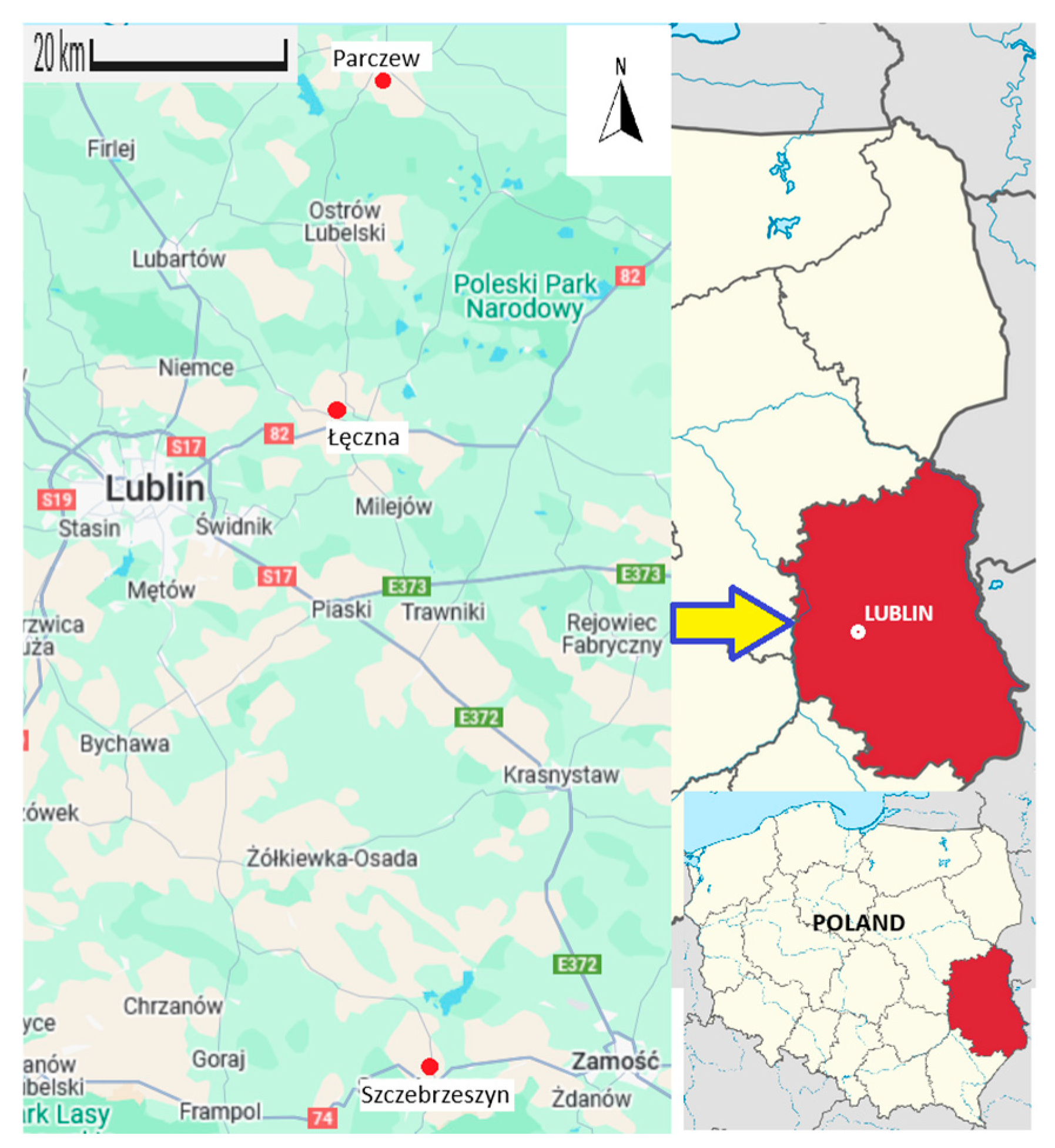
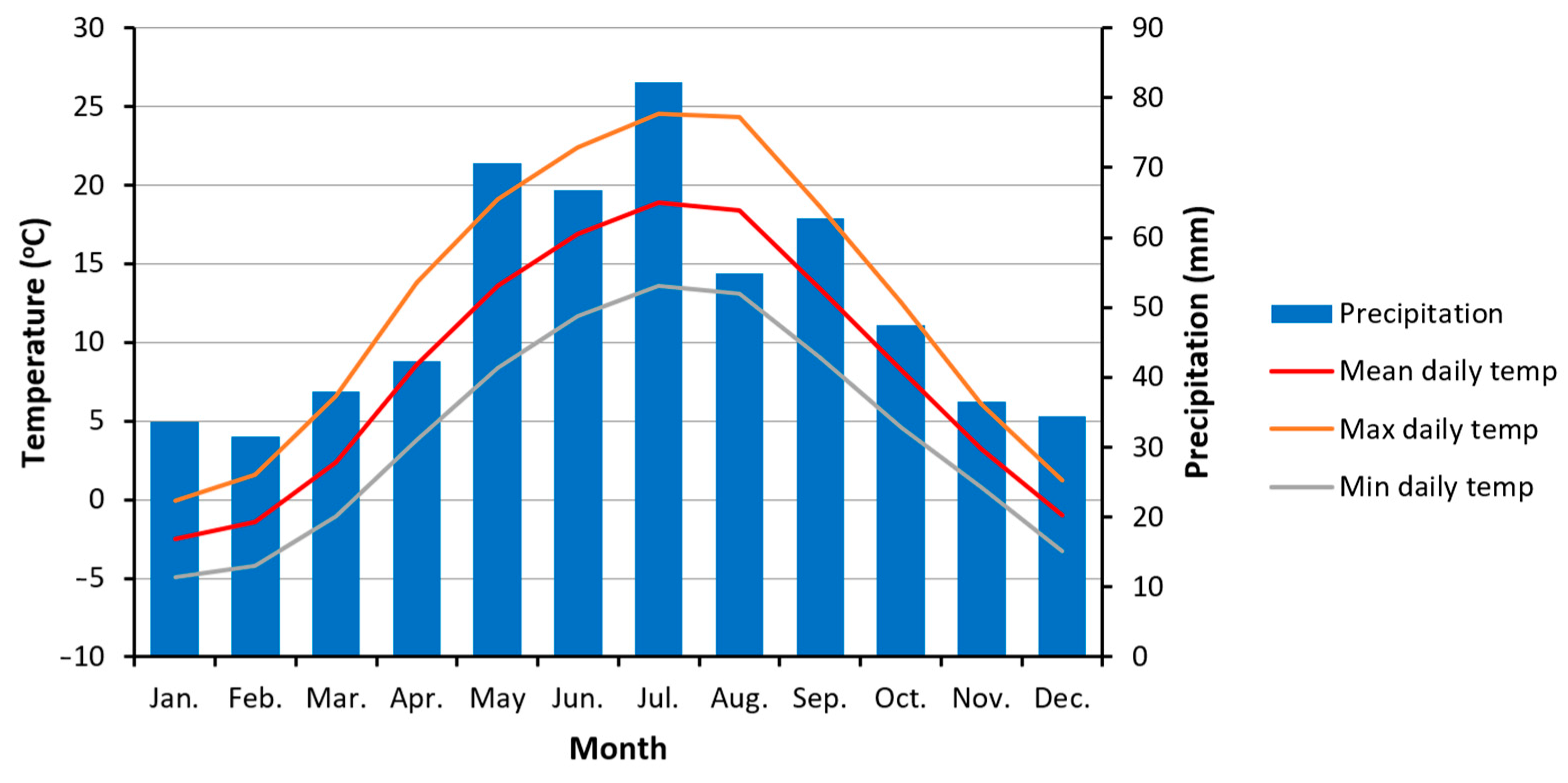
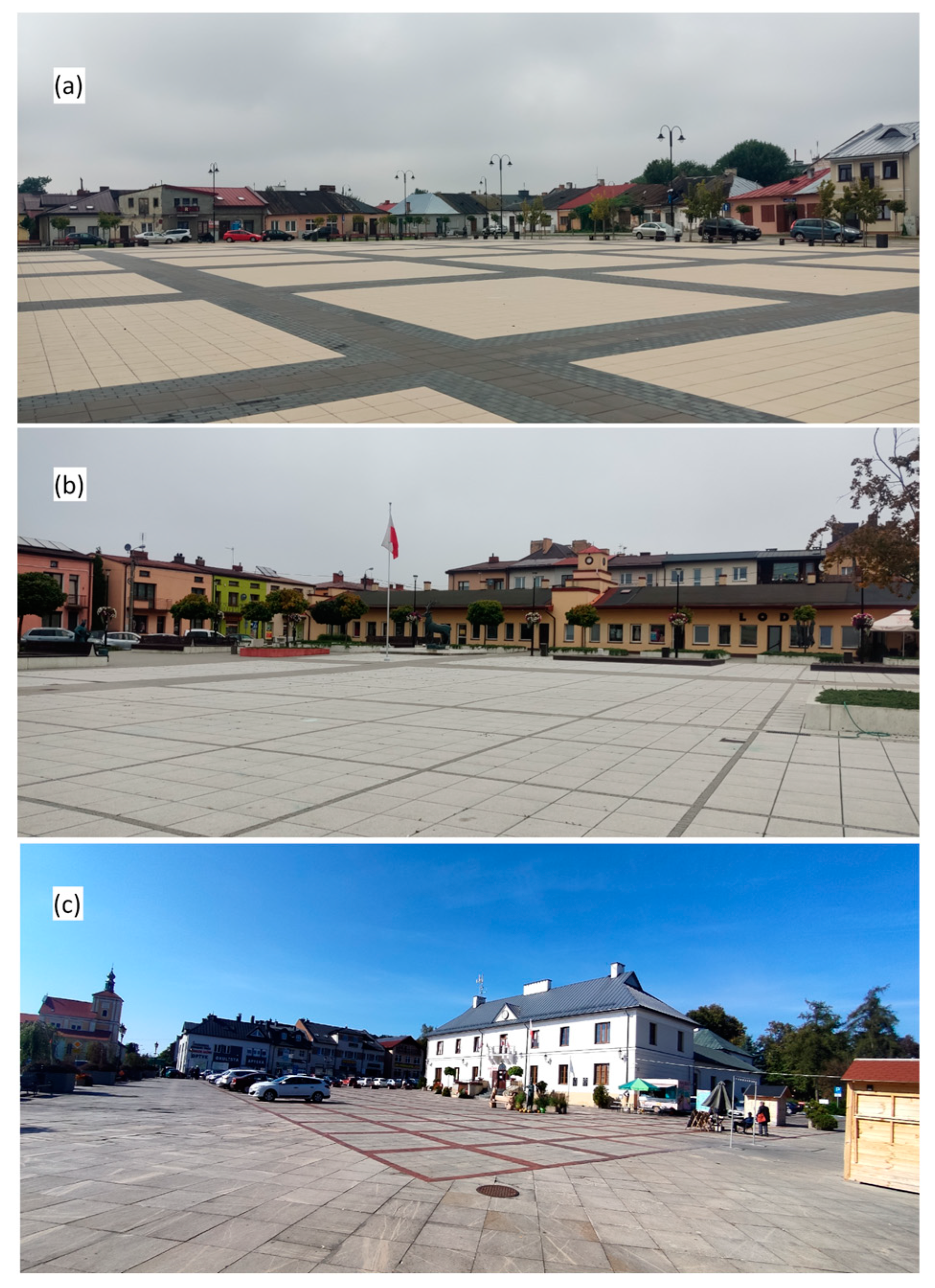
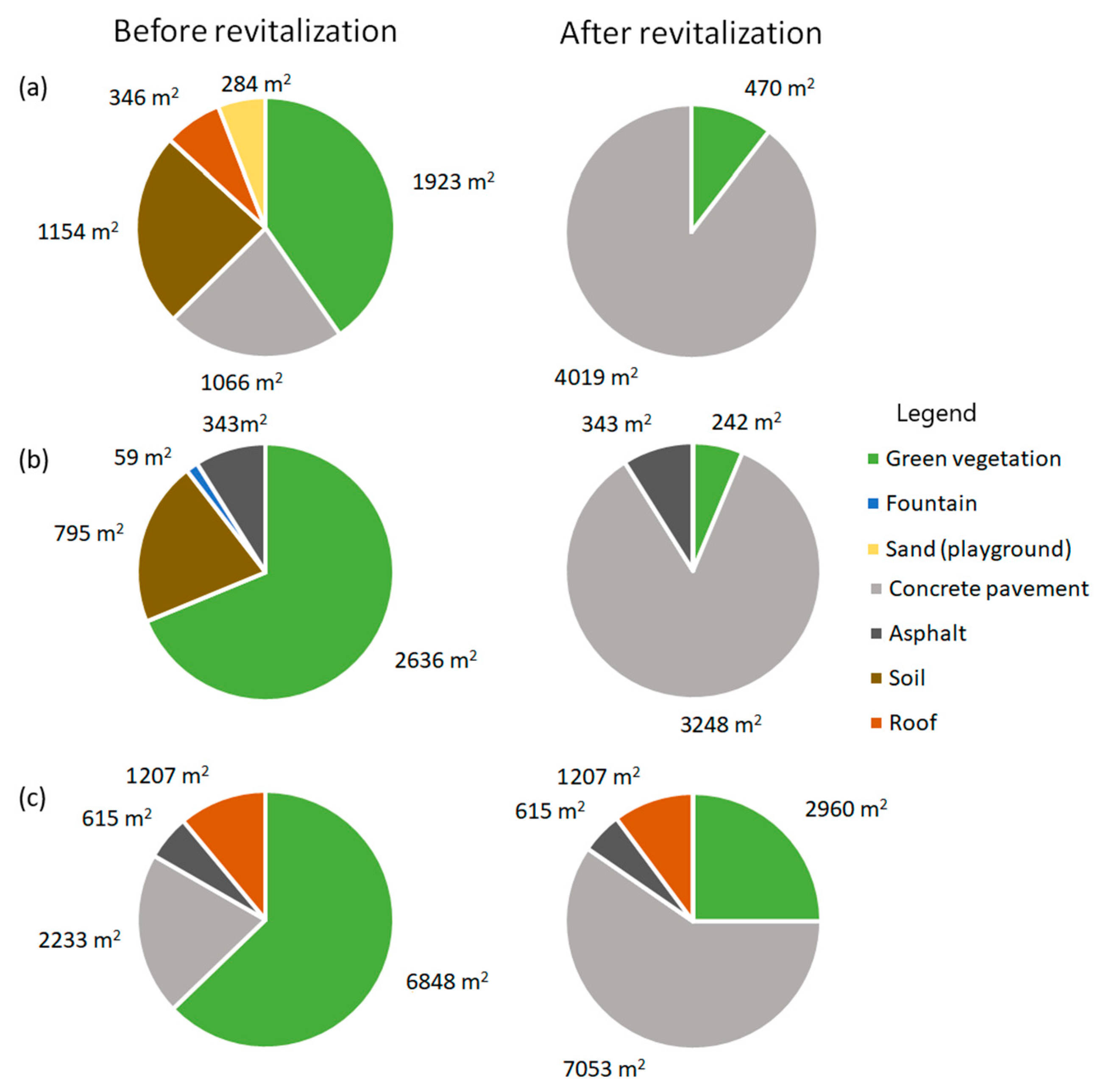

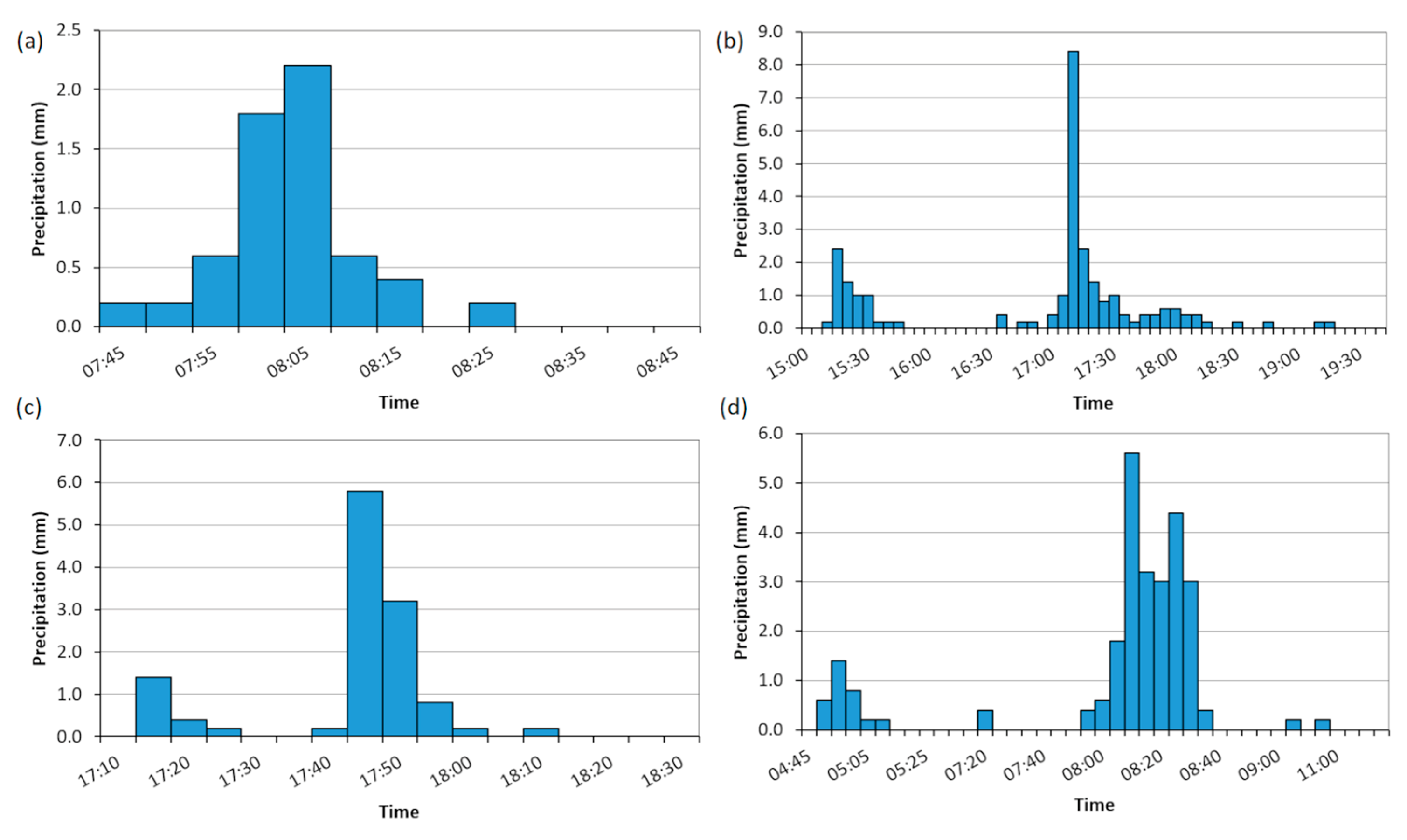
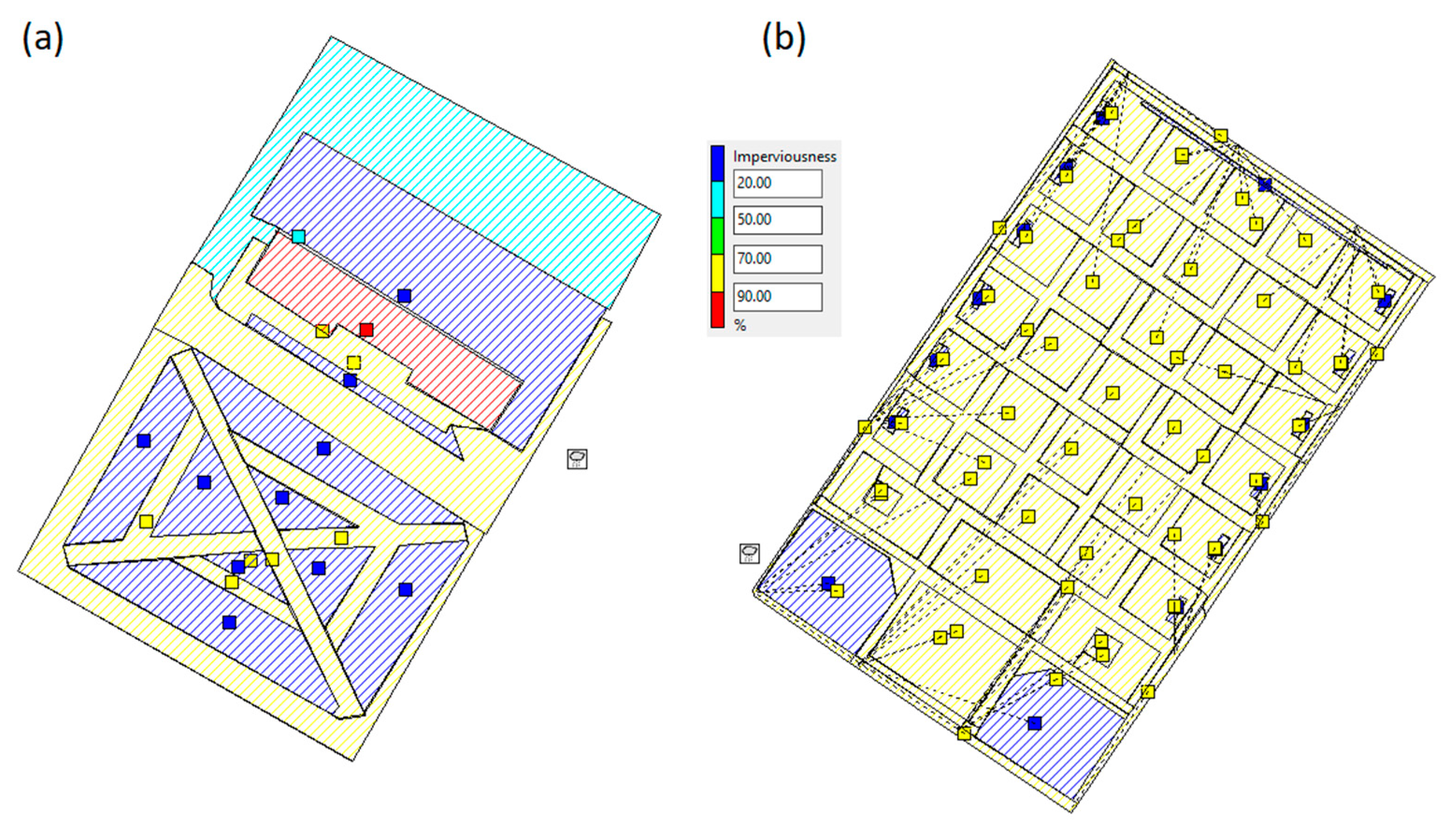
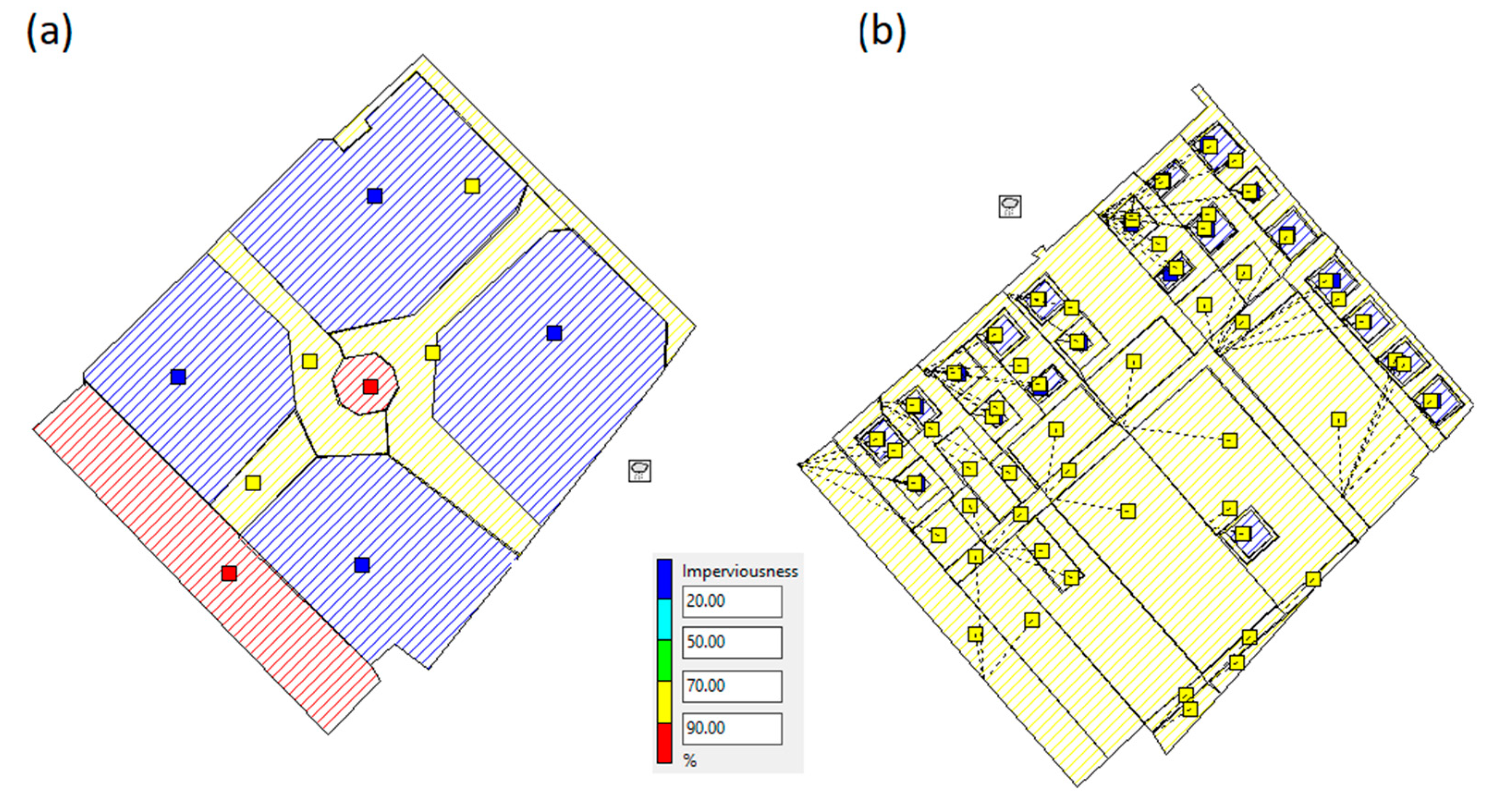
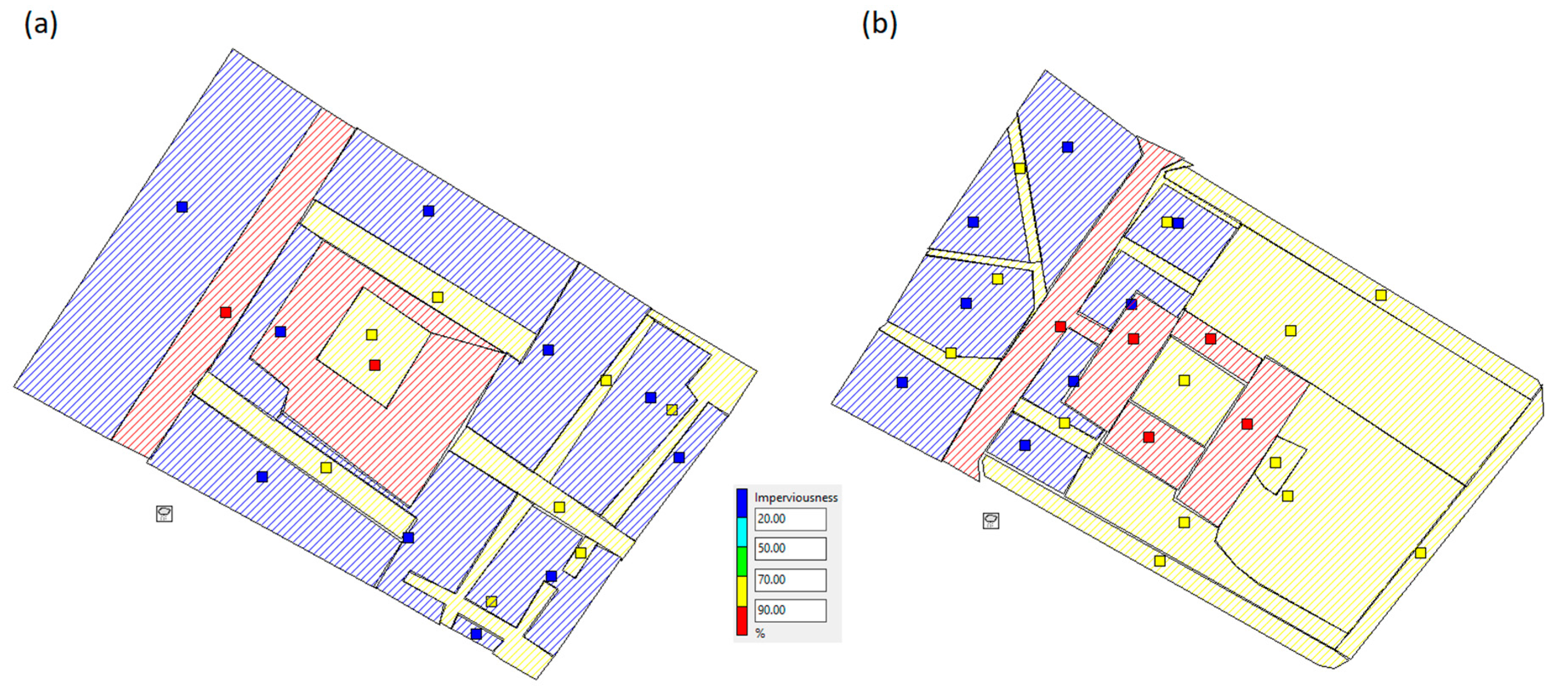
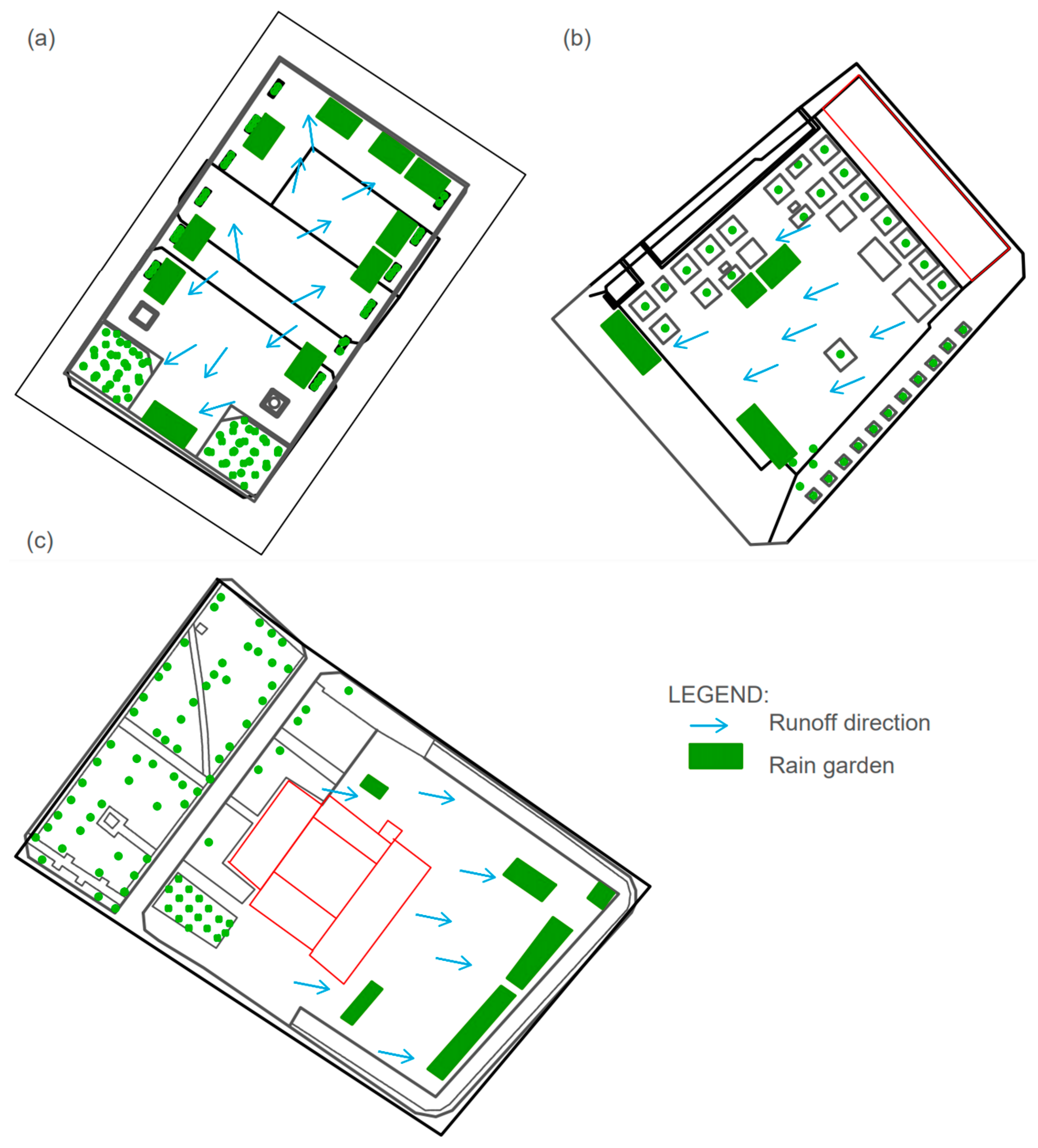

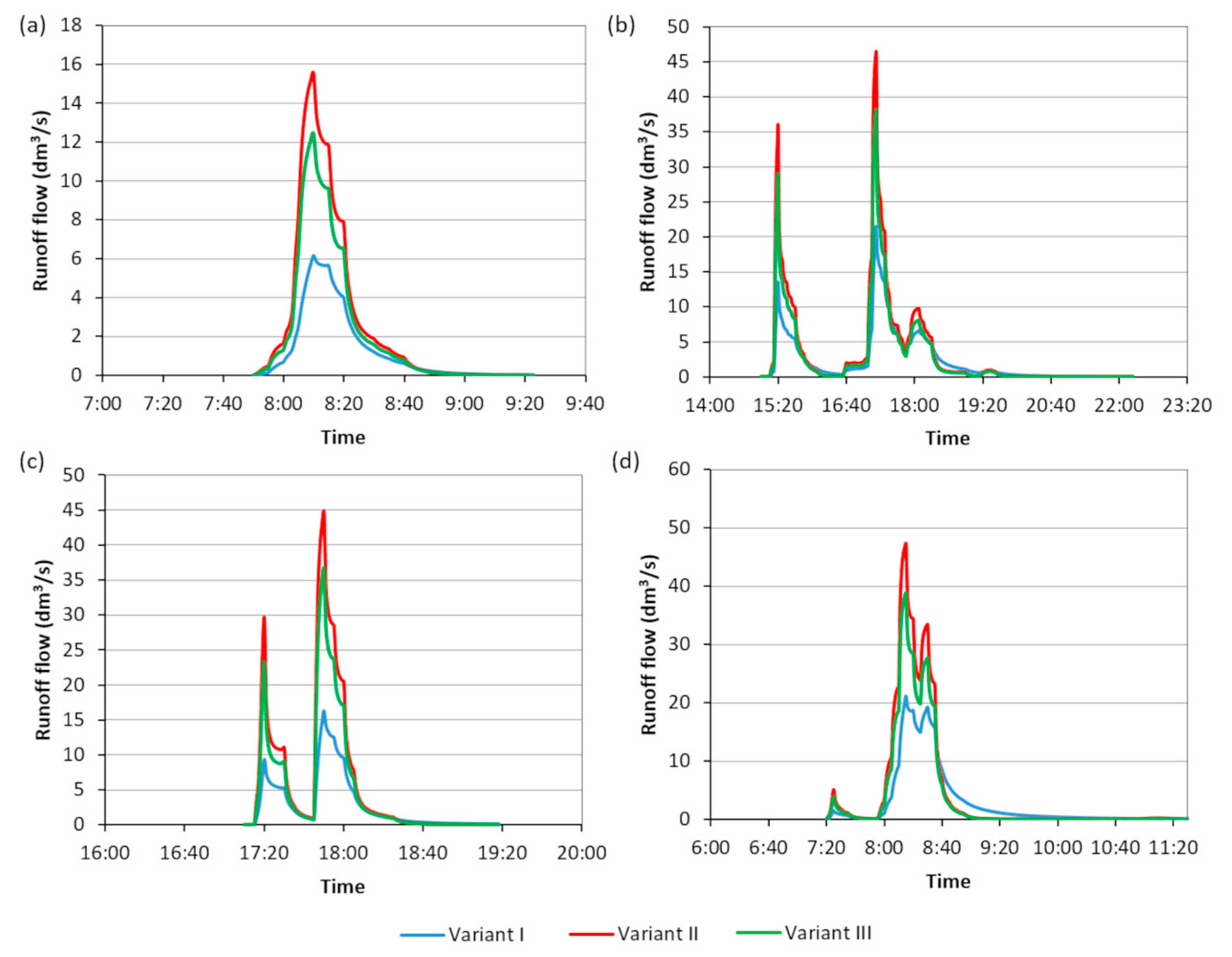


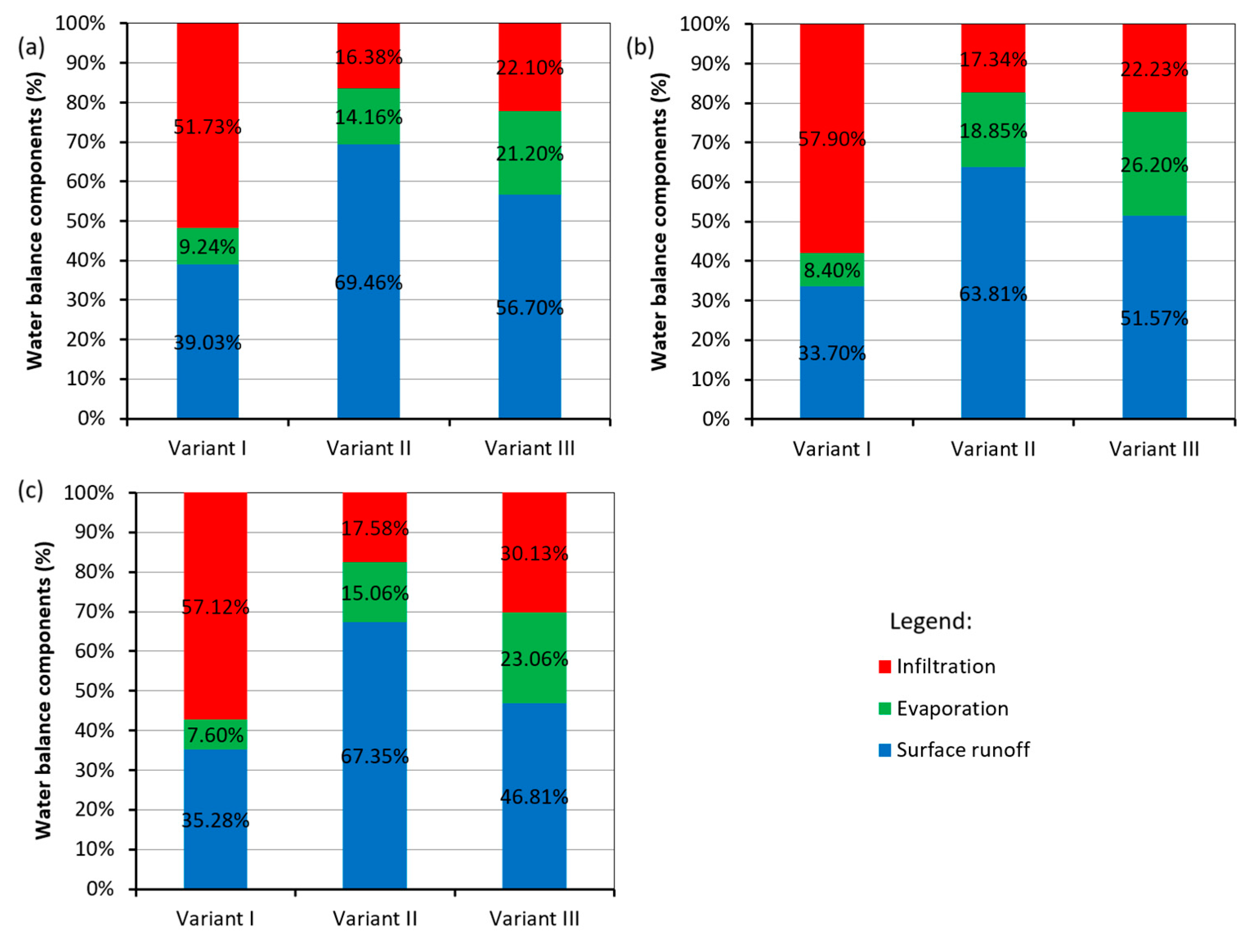
| Catchment | Output | Before Revitalization | After Revitalization | ||
|---|---|---|---|---|---|
| N Imperv | N Perv | N Imperv | N Perv | ||
| Leczna | Runoff volume | −0.00608 | −0.01283 | −0.0043 | −0.00134 |
| Runoff peak flow | −0.08573 | −0.00993 | −0.0265 | −0.01723 | |
| Parczew | Runoff volume | −0.00768 | −0.00204 | −0.00491 | −0.00171 |
| Runoff peak flow | −0.0988 | −0.00694 | −0.04127 | −0.02565 | |
| Szczebrzeszyn | Runoff volume | −0.01025 | −0.00221 | −0.00725 | −0.00209 |
| Runoff peak flow | −0.1408 | −0.00593 | −0.09317 | −0.03152 | |
Disclaimer/Publisher’s Note: The statements, opinions and data contained in all publications are solely those of the individual author(s) and contributor(s) and not of MDPI and/or the editor(s). MDPI and/or the editor(s) disclaim responsibility for any injury to people or property resulting from any ideas, methods, instructions or products referred to in the content. |
© 2025 by the authors. Licensee MDPI, Basel, Switzerland. This article is an open access article distributed under the terms and conditions of the Creative Commons Attribution (CC BY) license (https://creativecommons.org/licenses/by/4.0/).
Share and Cite
Widomski, M.K.; Musz-Pomorska, A. Hydrologic Efficiency of Rain Gardens as Countermeasures to Overuse of Concrete in Historical Public Spaces. Sustainability 2025, 17, 2527. https://doi.org/10.3390/su17062527
Widomski MK, Musz-Pomorska A. Hydrologic Efficiency of Rain Gardens as Countermeasures to Overuse of Concrete in Historical Public Spaces. Sustainability. 2025; 17(6):2527. https://doi.org/10.3390/su17062527
Chicago/Turabian StyleWidomski, Marcin K., and Anna Musz-Pomorska. 2025. "Hydrologic Efficiency of Rain Gardens as Countermeasures to Overuse of Concrete in Historical Public Spaces" Sustainability 17, no. 6: 2527. https://doi.org/10.3390/su17062527
APA StyleWidomski, M. K., & Musz-Pomorska, A. (2025). Hydrologic Efficiency of Rain Gardens as Countermeasures to Overuse of Concrete in Historical Public Spaces. Sustainability, 17(6), 2527. https://doi.org/10.3390/su17062527








